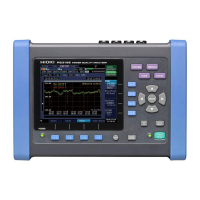7.5 Displaying Flicker Values in Graph and List Form
131
Chapter 7 Monitoring Fluctuations in Measured Values
(TIME PLOT Screen)
7
Flicker meters are used to measure the sensation of visual instability that occurs due to changes in light
source brightness and wavelength. There are two types of flicker meters: IEC flicker meters (UIE flicker
meters), which comply with IEC standards, and ΔV10 flicker meters, which are used domestically in
Jap
an. Both types of flicker meter observe fluctuations in voltage and display values used to objectively
judge flicker.
This section describes how to display
an IEC flicker fluctuation graph.
7.5 Displaying Flicker Values in Graph and List
Form
• Flicker measurement cannot be performed during 400 Hz measurement.
• The graph is not displayed unless [Flicker] is set to [Pst, Plt] in [SYSTEM]-DF1 [Main]-
F2 [Measure2].
IEC flicker meters and ΔV10 flicker meters
Displaying an IEC flicker fluctuation graph
[TIME PLOT]
screen
[Flicker]
[Graph]
Select with the F key.
To change the displayed channels (p.132)
To enlarge or reduce the graph (p.132)
To read the value above the cursor (p.133)
To scroll waveform data (p.133)
• The graph is updated every 10 minutes, regardless of the [TIME PLOT Interval] set
in [SYSTEM]-DF1 [Record]- F1 [
Interval](p.77).
• Urms1/2, Irms1/2, Freq_wav, and Pinst a
re recorded continuously.
• Due to the influence of the high pass filter used, measured values are unstable when
sta
rting Pst, Plt measurement immediately after settings have been configured, and the
initial measured value may be excessively high. It is recommended to wait about 2 min-
utes after making settings on the [S
YSTEM] screen before starting measurement.

